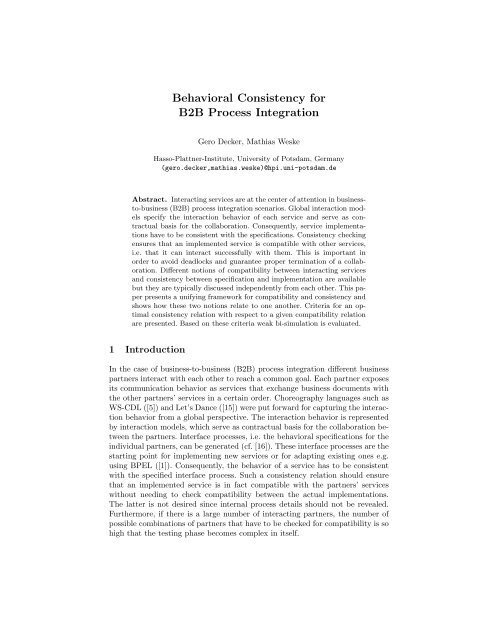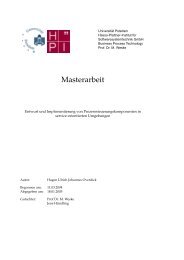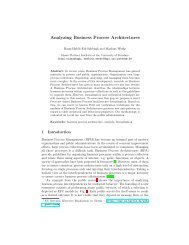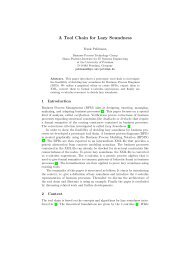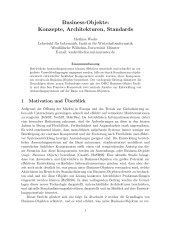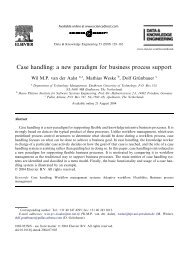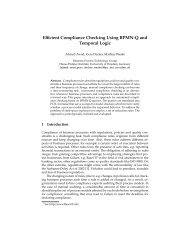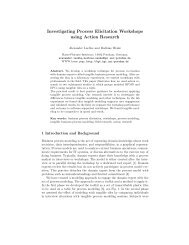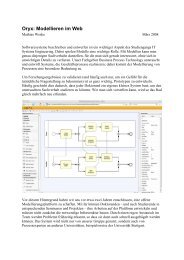Behavioral Consistency for B2B Process Integration - Business ...
Behavioral Consistency for B2B Process Integration - Business ...
Behavioral Consistency for B2B Process Integration - Business ...
You also want an ePaper? Increase the reach of your titles
YUMPU automatically turns print PDFs into web optimized ePapers that Google loves.
<strong>Behavioral</strong> <strong>Consistency</strong> <strong>for</strong><strong>B2B</strong> <strong>Process</strong> <strong>Integration</strong>Gero Decker, Mathias WeskeHasso-Plattner-Institute, University of Potsdam, Germany(gero.decker,mathias.weske)@hpi.uni-potsdam.deAbstract. Interacting services are at the center of attention in businessto-business(<strong>B2B</strong>) process integration scenarios. Global interaction modelsspecify the interaction behavior of each service and serve as contractualbasis <strong>for</strong> the collaboration. Consequently, service implementationshave to be consistent with the specifications. <strong>Consistency</strong> checkingensures that an implemented service is compatible with other services,i.e. that it can interact successfully with them. This is important inorder to avoid deadlocks and guarantee proper termination of a collaboration.Different notions of compatibility between interacting servicesand consistency between specification and implementation are availablebut they are typically discussed independently from each other. This paperpresents a unifying framework <strong>for</strong> compatibility and consistency andshows how these two notions relate to one another. Criteria <strong>for</strong> an optimalconsistency relation with respect to a given compatibility relationare presented. Based on these criteria weak bi-simulation is evaluated.1 IntroductionIn the case of business-to-business (<strong>B2B</strong>) process integration different businesspartners interact with each other to reach a common goal. Each partner exposesits communication behavior as services that exchange business documents withthe other partners’ services in a certain order. Choreography languages such asWS-CDL ([5]) and Let’s Dance ([15]) were put <strong>for</strong>ward <strong>for</strong> capturing the interactionbehavior from a global perspective. The interaction behavior is representedby interaction models, which serve as contractual basis <strong>for</strong> the collaboration betweenthe partners. Interface processes, i.e. the behavioral specifications <strong>for</strong> theindividual partners, can be generated (cf. [16]). These interface processes are thestarting point <strong>for</strong> implementing new services or <strong>for</strong> adapting existing ones e.g.using BPEL ([1]). Consequently, the behavior of a service has to be consistentwith the specified interface process. Such a consistency relation should ensurethat an implemented service is in fact compatible with the partners’ serviceswithout needing to check compatibility between the actual implementations.The latter is not desired since internal process details should not be revealed.Furthermore, if there is a large number of interacting partners, the number ofpossible combinations of partners that have to be checked <strong>for</strong> compatibility is sohigh that the testing phase becomes complex in itself.
2 Gero Decker, Mathias WeskeWhile different consistency relations have been reported in the literature,overarching criteria <strong>for</strong> evaluating consistency relations <strong>for</strong> specific purposes hasnot been proposed yet. This paper argues that a consistency relation can bechecked <strong>for</strong> suitability with respect to a specific compatibility relation. E.g. thecompatibility relation could allow that certain interactions never happen or thatmessages sent by one service are ignored by another one. Having chosen a suitablecompatibility relation <strong>for</strong> a given context, we provide the criteria to decidewhether a given consistency relation is optimal or not.Existing notions of compatibility and consistency are discussed in the nextsection. Section 4 provides a <strong>for</strong>mal definition of what an optimal consistencyrelation is with respect to a given compatibility notion. Section 5 elaborates onpossible refinements from a process specification to an implementation. Sinceweak bi-simulation is a common <strong>for</strong>mal basis <strong>for</strong> consistency checking, we willinvestigate in Section 6 whether it is optimal <strong>for</strong> the selected compatibility notions.Section 7 concludes and gives an outlook to future work.2 Compatibility and <strong>Consistency</strong> in <strong>B2B</strong> ScenariosCompatibility is the ability of a set of interconnected services to interact successfully.<strong>Consistency</strong> between a service implementation and a service specificationis given if the implementation is valid with respect to the specification. In theliterature also other names such as process inheritance are used as synonyms <strong>for</strong>consistency (cf. [4], [2]).This section will further explain the need <strong>for</strong> compatibility and behavioralconsistency using a <strong>B2B</strong> scenario. Figure 1 gives an overview over the partnersin that scenario: A buyer (e.g., car manufacturer) uses reverse auctioning <strong>for</strong>procuring specially designed components. In order to get help with selecting theright suppliers and organizing and managing the auction, the buyer outsourcesthese activities to an auctioning service. The auctioning service advertises theauction, be<strong>for</strong>e different suppliers can request the permission to participate init. The suppliers determine the shipper that would deliver the components tothe buyer or provide a list of shippers with different transport costs and qualitylevels, where the buyer can choose from. Once the auction has started, thesuppliers can bid <strong>for</strong> the lowest price. At the end, the buyer selects the supplieraccording to the lowest bid or according to other criteria. After the auction isover, the auctioning service has to be paid <strong>for</strong> and shipment details are dealtwith. Finally, the components are delivered to the buyer and are paid <strong>for</strong>.It is obvious that there can be several suppliers, auctioning services, shippersand buyers. There<strong>for</strong>e, different combinations of participants must be able tointeract successfully. Unsuccessful interaction behavior could arise e.g., if differentmessage <strong>for</strong>mats are used in the collaboration and one participant doesnot understand the message content sent by other participants. Another sourceof incompatibility, which we will mainly focus on, is behavioral incompatibility.Imagine that a participant expects a notification at some point in a process be<strong>for</strong>eit can proceed and none of the other participants ever sends such a notification.
<strong>Behavioral</strong> <strong>Consistency</strong> <strong>for</strong> <strong>B2B</strong> <strong>Process</strong> <strong>Integration</strong> 3AS1AS5Su1AuctioningServiceSh1SupplierShipperSh20Su100BuyerB1B200CompatibilityrelationSpecification<strong>Consistency</strong>relationImplementationFig. 1. Participants and roles in a reverse auctioning scenarioWe call this situation a deadlock. In order to avoid deadlock situations and toensure interoperability, the participants can agree on a certain desired interactionbehavior. The behavioral constraints between message exchanges would becaptured from the perspective of an ideal observer and the constraints <strong>for</strong> thecommunication behavior of every participant (the interface process) could be derivedfrom such an interaction model (the choreography). This specification thenserves as contractual basis <strong>for</strong> the collaboration and violations of the interactioncontract could have legal consequences.Figure 2 depicts a part of the collaboration specification where suppliers canrequest permission to the auction. We see that the roles supplier, auctioningservice and seller take part in this collaboration. For each of these roles aninterface process is given in the <strong>for</strong>m of a Petri net. The places on the border ofthe dashed rectangle depict the structural interface of each role, i.e. the typesof messages a role can potentially send or receive. The control flow betweenthe communication actions constrains the execution. A “?” symbolizes a receiveaction and “!” a send action.The supplier places a participation request at the auctioning service. Theservice <strong>for</strong>mulates a recommendation whether to accept this supplier or not.This recommendation is normally based on previous experience with the supplieror legal requirements. The auctioning service sends the recommendation to thebuyer. The buyer is not bound to this recommendation and can freely chosewhether to accept or reject the supplier. Finally, the auctioning service <strong>for</strong>wardsthe decision of the buyer on to the supplier.This specification does not tell the individual participants how their internalbehavior should look like. The auctioning service could, <strong>for</strong> instance, lookuphistorical data about the supplier be<strong>for</strong>e coming up with a recommendation;also the buyer could have an internal decision making process possibly span-
4 Gero Decker, Mathias WeskeSupplierAuctioning ServiceBuyer!participation_reqprpr?participation_reqrara!rec_accept!rec_rejectrrrr?rec_reject?rec_acceptbaba?accept?rejectbrbr!reject!accept?reject?acceptarar!accept!reject!notifynn?notifyFig. 2. Interface processes: Getting a participation permissionning different organizational units. No matter how the internal processes looklike, we are concerned that the different participants successfully collaborate, i.e.that the implementations are compatible. Ensuring compatibility is a challengingand cumbersome task when dealing with a large number of participants inthis auctioning scenario, involving e.g., 100 suppliers, 20 shippers, 5 auctioningservices and 200 buyers.A remedy <strong>for</strong> this situation is the notion of consistency between interfaceand executable processes. The interface processes are the specifications <strong>for</strong> thedifferent roles. <strong>Consistency</strong> between an interface process and the actual processimplementation should ensure that the given implementation can interactwith implementations <strong>for</strong> the other roles (provided that they in turn are consistentwith their respective interface process). That way, we can locally checkwhether or not a participant should be allowed to be involved in the collaborationscenario. Compatibility between different implementations does not need tobe checked any more.
<strong>Behavioral</strong> <strong>Consistency</strong> <strong>for</strong> <strong>B2B</strong> <strong>Process</strong> <strong>Integration</strong> 53 Compatibility and <strong>Consistency</strong> NotionsIn recent years there has been extensive work on different compatibility notions<strong>for</strong> interacting processes. This section compares four different notions, namelythe compatibility notion by Martens [6], the compatibility notion by Canal et al.[4], interaction soundness by Puhlmann et al. [10] and the well-communicatingrequirement used in the operating guidelines approach by Massuthe et al. [8, 9].Furthermore, this section will present different existing consistency notions.Compatibility. First, we can distinguish between structural compatibility andbehavioral compatibility. Structural compatibility like presented as “syntacticcompatibility” in [6] demands that <strong>for</strong> every message that can be sent, the correspondinginteraction partner must be able to receive it. Futhermore, <strong>for</strong> everymessage that can be received the corresponding partner must be able to sendsuch a message. I.e. in the case of web service architectures the receiving servicemust have a matching operation <strong>for</strong> every outgoing SOAP message of thesending service, and <strong>for</strong> every operation a sending service must be able to senda corresponding message. We call this notion strong structural compatibility. Inother compatibility notions, e.g. the well-communicating requirement, strongstructural compatibility is not required. This acknowledges the fact that if aservice provides a certain operation, the partners do not necessarily need toinvoke this operation. However, it is still required that <strong>for</strong> every message sentthere must be a corresponding operation. We call this weak structural compatibility.One could also think of examples where even weak structural compatibilityis too restrictive: a middleware plat<strong>for</strong>m might be configurable in such a waythat unprocessable messages are simply ignored. E.g. notifications that are notnecessarily needed might not be received in some process. For such scenarioswe introduce the notion of minimal structural compatibility. Minimal structuralcompatibility requires that there is at least one potential message send with acorresponding message receive by another participant.Figure 3 presents three alternative service implementations <strong>for</strong> the buyerin our reverse auctioning example. We see that internal actions were added inthe case of B1 and B3 (e.g. “Add to blacklist” and “Store decision”). B1 isstructurally equivalent to the buyer in Figure 2 but has a different control flowstructure. This alternative has strong structural compatibility with the Supplierand Auctioning Service, since every message sent can be received and <strong>for</strong> everymessage that can be received there is a message sent. This applies <strong>for</strong> bothincoming and outgoing messages. B2 has only weak structural compatibility,since the Auctioning Service could receive a reject message from the buyer butthe buyer never sends one. B3 does not have weak structural compatibility withthe other participants: the notification sent by the Auctioning Service cannotbe received by the buyer. However, since there are messages sent that can bereceived by the buyer, minimal structural compatibility is still given.In contrast to structural compatibility, behavioral compatibility considersbehavioral dependencies, i.e. control flow, between different message exchangeswithin one conversation. In most approaches the interface processes of the inter-
6 Gero Decker, Mathias Weskerarr?rec_reject?rec_acceptbabr!reject!acceptn?notifyBuyerB1<strong>B2B</strong>3rarr?rec_reject?rec_acceptrarr?rec_reject?rec_acceptrarr?rec_reject?rec_acceptadd toblacklistbaStore decisionba!acceptbr!reject!acceptLook uphistorical datan?notifyn?notifybabr!reject!acceptFig. 3. Alternative implementations <strong>for</strong> the buyeracting partners are interconnected and reasoning is done on the resulting globalprocess.Martens bases his compatibility notion on interconnected workflow modulesand requires strong structural compatibility. These modules are Petri nets withinput, output and internal places (like the examples in Figures 2 and 3). Whencomposing them, corresponding input and output places of interacting processesare merged and a global initial place and a global final place are added. Martensdefines “weak soundness” on the global process, requiring that the final markingmust always be reachable. This ensures that the global process is free of deadlocksand livelocks.Canal et al. have also defined a compatibility notion <strong>for</strong> interactingπ-processes. A main advantage of using π-calculus is the availability of linkpassing mobility. I.e. communication channels between interacting processes donot need to be statically defined but can be established at runtime. In real worldsettings this is called dynamic binding. E.g. a service broker passes the reference
<strong>Behavioral</strong> <strong>Consistency</strong> <strong>for</strong> <strong>B2B</strong> <strong>Process</strong> <strong>Integration</strong> 7to a provided service on to a service consumer who can then use the service.π-interactions are atomic, i.e. sending and receiving of messages happen at thesame time. There<strong>for</strong>e, it is not possible that one π-process sends a message whichis not consumed by the other. The compatibility notion by Canal et al. requiresthat both processes complete, i.e. that no more sending or receiving action is leftto be per<strong>for</strong>med. A major drawback of the given compatibility notion is that itis defined <strong>for</strong> bi-lateral settings only.Interaction soundness is based on “lazy soundness” of the global process. It isrequired that the process always completes, while some activities are still allowedto run even after completion. Considering these “lazy activities” is essential <strong>for</strong>coping with advanced control flow constructs such as Discrimators (cf. [12]) butleads to the fact that livelocks cannot be detected in some situations. Interactionsoundness is defined <strong>for</strong> a combination of a service and its environment. We find amixture of strong and minimal structural compatibility between the service andits environment: The environment must be able to send and receive all those kindof messages that the service can receive or send. There<strong>for</strong>e, there must be strongstructural compatibility in one direction. However, the service is not requiredto send and receive all those kind of messages that the environment is able toreceive or send. Interaction soundness is defined on π-calculus. There<strong>for</strong>e, it canalso deal with link passing mobility.The operating guidelines approach to checking compatibility [8, 9] is differentto the three previous approaches in that it does not reason on interconnectedinterface processes. Rather an “operating guideline” can be generated <strong>for</strong>an interface process which includes all valid interaction behavior that respectsthe well-communicating requirement. This requirement includes weak structuralcompatibility and the absence of deadlocks and livelocks. Operating guidelinesare annotated state machines and represent the most permissive interaction behavior<strong>for</strong> the interaction partners. The interface processes of the partners (alsogiven as state machines) must then be sub state machines of the most permissivebehavior. The main motivation behind the operating guidelines approach is toreach a smaller computational complexity <strong>for</strong> compatibility checking. A currentlimitation of operating guidelines is that only acyclic processes are allowed.<strong>Consistency</strong>. There has been quite some research work on consistency relationsbetween specified interface processes and process implementations comparingtheir observable behavior. Basten et al. introduce different notions ofprocess inheritance in [2], namely protocol inheritance, projection inheritance,protocol/projection inheritance and life-cycle inheritance. In order to determinewhether an implementation is a subclass of a given specification, encapsulationand abstraction mechanisms are employed. Encapsulation deletes additional activitiesfrom the implementation be<strong>for</strong>e comparing it to the specification, whileabstraction re-labels certain activities as τ-actions, i.e. they are not consideredin the weak bi-simulation relation. Once encapsulation and abstraction is applied,branching bi-simulation is used to compare the two process definitions.Bi-simulation relations were defined <strong>for</strong> different <strong>for</strong>malisms. These results are
8 Gero Decker, Mathias Weskeused in the public to private approach reported in [13], where participants agreeon a global interaction model and a partitioning of this model to participants.Using inheritance mechanisms, each partner can implement an arbitrary subclassof their public process as a local, private implementation. The inheritance rulesmake sure that the private implementations satisfy the interaction constraintsdefined in the public model.Other examples <strong>for</strong> (bi-)simulation relations are weak open (bi-)simulation<strong>for</strong> π-calculus by Sangiorgi [11] and branching bi-simulation <strong>for</strong> Petri nets byvan Glabbeek and Weijland [14]. Bi-simulation in general will be discussed insection 6. Busi et al. have introduced their own calculi <strong>for</strong> choreographies andorchestrations in [3]. <strong>Consistency</strong> between orchestration and the specified behavior,which is given in the choreography, is shown through a bi-simulation-likerelation, which is also defined by the authors. Martens presents a consistencyrelation in [7] where the implementation must accept at least those messagesspecified and must produce at most those messages specified.4 Optimal <strong>Consistency</strong> RelationsThe previous section recapitulates different notions of compatibility and consistency.<strong>Consistency</strong> is dependant on compatibility and should go hand in handwith it. There<strong>for</strong>e, this section introduces a means to judge whether or not agiven consistency relation is suited <strong>for</strong> a given compatibility notion. The followingtwo requirements <strong>for</strong> consistency relations can be identified:1. A consistency relation should ensure compatibility. If a set of specified servicedefinitions are compatible and a set of implementations are consistent withthese specifications then this set must also be compatible. Figure 4 illustratesthis. If A spec , B spec and C spec are compatible and A impl is consistent withA spec , B impl with B spec and C impl with C spec , then A impl , B impl and C implmust also be compatible.2. A consistency relation should not be too restrictive. The consistency relationshould be maximal, i.e., every possible extension to the consistency relationmust result in the violation of the previous requirement.In the remainder of this section the abovementioned requirements are <strong>for</strong>malized.To allow <strong>for</strong> reusing the definitions <strong>for</strong> arbitrary compatibility and consistencynotions, the <strong>for</strong>malization is independent from a particular <strong>for</strong>malism(such as Petri nets or π-calculus). We introduce as follows:– S is a set of service definitions,– C ⊆ ℘(S) is the set of all compatible combinations of service definitions and– ≽⊆ S × S is a binary relation on S where s impl ≽ s spec denotes that servicedefinition s impl is consistent with service definition s spec .In the example shown in Figure 4, all spefications and implementations areservice definitions: A spec , B spec , C spec , A impl , B impl , C impl ∈ S, the set of specificationsand the set of implementations are compatible, respectively: {A spec ,
<strong>Behavioral</strong> <strong>Consistency</strong> <strong>for</strong> <strong>B2B</strong> <strong>Process</strong> <strong>Integration</strong> 9A implA specA implB implB specB implC specC implC implFig. 4. The consistency relation must respect the compatibility notionB spec , C spec }, {A impl , B impl , C impl } ∈ C and the implementations are consistentwith their respective specifications: (A spec , A impl ), (B spec , B impl ), (C spec ,C impl ) ∈ ≽.An auxiliary relation is introduced, ≽ ′ := {(c 1 , c 2 ) ∈ ℘(S) × ℘(S) | ∀s 1 ∈c 1 [∃s 2 ∈ c 2 (s 1 ≽ s 2 )] ∧ ∀s 2 ∈ c 2 [∃s 1 ∈ c 1 (s 1 ≽ s 2 )]: All service definitions s 1in one set are consistent with at least one service definition s 2 in the other setand there is no s 2 without at least one s 1 that is consistent with it.Based on these definitions, we can <strong>for</strong>malize the two requirements <strong>for</strong> optimalconsistency relations: A consistency relation ≽ is optimal <strong>for</strong> a compatibilitynotion C if and only if1. ≽ respects C, i.e. ∀c 1 , c 2 ∈ ℘(S) [(c 2 ∈ C ∧ c 1 ≽ ′ c 2 ) ⇒ c 1 ∈ C]2. ∀(s 1 , s 2 ) ∈ S × S [¬(s 1 ≽ s 2 ) ⇒ ¬((≽ ∪ {(s 1 , s 2 )}) respects C)]The first line states that a combination of service definitions c 1 must becompatible, if c 1 is consistent with a combination of service definitions c 2 thatare compatible. We have introduced the relation respects ⊆ (S × S) × ℘(S)indicating which consistency relation respects which compatibility notion. Thesecond line states that adding a new tuple (s 1 , s 2 ) of service definitions to theconsistency relation must result in breaking the first requirement. I.e. we mustnot disallow any implementation that would successfully interact with the otherallowed implementations.5 <strong>Process</strong> Refinement CategoriesThe definition of optimal consistency relations in the previous section allowsto decide a true/false decision about the suitability of a given consistency relation.In this section we want to describe some typical process refinements, i.e.differences between specified interface processes and process implementations.
10 Gero Decker, Mathias WeskeAn optimal consistency relation is expected to support all these process refinements,provided that the compatibility notion is permissive enough. The list ofrefinement categories allows to compare compatibility and consistency notionswith respect to engineering needs. If a consistency relation is not optimal <strong>for</strong> agiven compatibility notion it probably provides less support <strong>for</strong> at least one ofthe categories. Unlike the requirements <strong>for</strong> optimal consistency relations we donot provide <strong>for</strong>mal definitions of the refinements.1. Addition of internal actions. Specified interface processes indicate whatinteraction behavior other participants can expect from an organization. Onthe other hand, a process implementation covers all internal activities anddependencies that are present within the organization. In other words, thespecified interface process constrains the interaction behavior of an organizationwhile the implementation contains all details <strong>for</strong> actually executingthe process. The implementation also shows interdependencies with otherprocesses running within the organization. There<strong>for</strong>e, additional internal activitiesthat are not visible outside the organization can be found in theprocess implementation.2. Addition of communication actions. The process implementation sometimesneeds to be able to comply to the constraints given in different interfaceprocesses. E.g. there might be different interaction contracts with upstreamand downstream partners in a supply chain scenario. In order to cope withsuch a situation the process implementation contains more communicationactions with partners than specified in one interface process.3. Deciding choices at design-time. If a partner is allowed to do choices,e.g. an organizational unit can decide whether to send an accept or rejectmessage (cf. the buyer in Figure 3), the specification indicates the latestmoment where the choice can be made. However, an organization mightdecide that always the same branch is taken. E.g. the buyer in the exampleof the previous section might decide to always accept a supplier (cf. B2 inFigure 3). There<strong>for</strong>e, the choice is already done at configuration time of thepartner’s system, i.e. design-time of the process implementation.4. Removal of communication actions. When deciding at design-time thatparticular branches should be taken then this results in removing communicationactions from the process that are part of the other branches. Thishas an influence on structural compatibility if all communication actions <strong>for</strong>a particular message type are deleted. Another reason <strong>for</strong> deleting receiveactions could be the knowledge that the sending party has done a designtimedecision never to take a certain branch. However, it can be argued thatsuch an implementation should not be allowed by the consistency relationbecause such an agreement between the two partners is not reflected in thespecification.5. Deciding choices earlier at runtime. It is also imaginable that a choiceis done sometime earlier in the process. E.g. an organizational unit decidesdependending on what message comes in sometimes earlier in the process.B1 in Figure 3 sends an accept or reject message if a corresponding rec-
<strong>Behavioral</strong> <strong>Consistency</strong> <strong>for</strong> <strong>B2B</strong> <strong>Process</strong> <strong>Integration</strong> 11ommendation comes in. There<strong>for</strong>e, the choice whether to send an accept orreject message is not done right be<strong>for</strong>e such a message is to be sent, as it isthe case in the specification, but the choice is rather done as soon as a recommendationis received. In other cases, deciding choices earlier at runtimedoes not have any visible effect <strong>for</strong> the outside world.6. Sequentialization of communication actions. Ideally, specified interfaceprocesses do not make any restrictions on the ordering of message productionand consumption if not absolutely necessary. E.g. once a supplier is selected,a buyer is required to initiate the payment <strong>for</strong> the auctioning service andsend delivery details to the designated shipper. Although there is no constraintin what order the buyer has to send the two messages, the processimplementation might sequentialize it. E.g. the shipper is always notified assoon as possible while the payment is delayed <strong>for</strong> a while.7. Reordering of communication actions. Consider a similar scenario likethe previous one: it is specified that a seller first receives payment details be<strong>for</strong>ehe receives the delivery details from the buyer. Assuming asynchronouscommunication, it might be allowed that the seller can reorder the consumptionof the two incoming messages <strong>for</strong> process optimization purposes: He firstprocesses the delivery details and initiates transport be<strong>for</strong>e he processes thepayment details.6 Assessment of Bi-simulation <strong>for</strong> <strong>Consistency</strong> CheckingSection 3 has shown that weak bi-simulation is the basis <strong>for</strong> several consistencyrelations. The main idea behind weak bi-simulation is that a process A can simulatethe communication behavior of process B and vice-versa, while internalactions are not considered. There<strong>for</strong>e, if A is capable of doing some communicationaction c then B must also be capable of doing c and again vice-versa. Inthe case of consistency checking we can there<strong>for</strong>e compare a specified interfaceprocess with a process implementation in terms of bi-similarity.Since two bi-simulation related processes A and B show equivalent communicationbehavior, it is easy to see that bi-simulation respects a wide range ofcompatibility notions. The first criterion <strong>for</strong> an optimal consistency relation isthere<strong>for</strong>e given. The remainder of this section investigates whether bi-simulationis too restrictive, i.e. if the second requirement <strong>for</strong> an optimal relation is met.Consider an example similar to the <strong>B2B</strong> scenario introduced in Section 2. InFigure 5 processes P 1 and P 2 are depicted having the same structural interfaceto the environment: Messages of type a and b can be received, and messagesof type c and d can be produced. Due to this structural equivalence, a and bhave the same degree of structural compatibility with any given environment.However, these processes show different behavior. In terms of combinations ofcommunication actions that are per<strong>for</strong>med within one process instance, processP 1 allows ?a.!c, ?a.!d, ?b.!c! and ?b.!d. On the other hand, P 2 only allows ?a.!cand ?b.!d. In this example, P 1 can simulate all behavior of P 2 but P 2 cannotsimulate all behavior of P 1 . There<strong>for</strong>e, P 1 and P 2 are not bi-simulation related.
12 Gero Decker, Mathias WeskeP1P2bba?a?ba?a?bcd!c!dcd!c!dFig. 5. P 1 and P 2 are not bi-simulation relatedP3P4e?ee?efg!f !gf!fg!gFig. 6. P 3 and P 4 are not bi-simulation relatedThe second example (Figure 6) leads to a similar situation. In P 3 no orderingconstraint between !f and !g is given, while in P 4 !f always happens be<strong>for</strong>e !g.P 3 there<strong>for</strong>e allows ?e.!f.!g and ?e.!g.!f, while P 4 only allows ?e.!f.!g. P 3 and P 4are not bi-simulation related.According to the consistency notions in [2] and [3], which are based on bisimulation,P 2 and P 4 would not be allowed as implementations <strong>for</strong> P 1 and P 3 .However, P 2 would be compatible with all environments that P 1 is compatiblewith. This is due to the fact that the environment must be able to receive c andd. The environment is not allowed to do any assumptions about which messageis to be received, otherwise it would be incompatible with P 1 . For this reason, itis just a special case that in P 2 the choice <strong>for</strong> c or d is linked to the previouslyreceived message. In analogy to this, we know that P 4 would be compatible withall environments that P 3 is compatible with.There<strong>for</strong>e we can conclude that bi-simulation is too restrictive as compatibilitynotion <strong>for</strong> the compatibility notions presented in section 3, since adding thetuples (P 1 , P 2 ) and (P 3 , P 4 ) to the consistency relation would not result in notrespecting any of the compatibility notions presented in section 3 any longer.
<strong>Behavioral</strong> <strong>Consistency</strong> <strong>for</strong> <strong>B2B</strong> <strong>Process</strong> <strong>Integration</strong> 13These examples also show that consistency relations do not need to be symmetric,i.e. that if a process A is consistent with process B, B does not need to beconsistent with A. Assume a process X allowing the two combinations !a.?c and!b.?d would be compatible with P 2 but not with P 1 : Assume that P 1 producesa message of type d after having received a message of type a, i.e. ?a.!d, theconversation would deadlock since X would expect a message of type c which inturn would never be sent in that conversation. Figure 7 depicts this situation.Since all presented compatibility notions detect such simple potential deadlocks,incompatibility holds with respect to all these notions.XP1bb!a!baa?a?b?c?dcdcd!c!dFig. 7. X and P 1 are not compatibleThe processes in Figures 5 and 6 are examples <strong>for</strong> the process refinementcategories presented in the previous section. In P 2 the choice whether a messageof type c or d is sent is made earlier than in P 1 , namely already as soon as amessage is consumed. P 4 is an example <strong>for</strong> the sequentialization of actions.Let us now take a look at the other categories from Section 5. Weak bisimulationdirectly supports the category addition of internal activities. Theadded activities are simply treated as τ-actions and are there<strong>for</strong>e ignored. Foraddition of communication actions it might be possible to re-label the addedactions as τ-actions be<strong>for</strong>e testing <strong>for</strong> bi-similarity. This pre-processing step issuggested in [2]. However, it cannot be generally allowed. Especially if messageexchanges <strong>for</strong> existing message types are added, compatibility with otherprocesses might be affected. Removing communication actions is not supportedthrough bi-simulation in the case of reachable communication actions. Decidingchoices at design-time is not supported (assuming that it affects the communicationbehavior). When deciding choices earlier at runtime the communicationbehavior is not affected in many real-world cases. There<strong>for</strong>e, we conclude thatthere is partial support <strong>for</strong> this category. Sequentialization and reordering ofcommunication actions are not supported through bi-simulation.Table 1 summarizes what categories of process refinements are supportedthrough weak bi-simulation. A “+” denotes that there is full support, “+/–”partial support and “–” indicates no support (including the assumptions madein the previous paragraph). The table highlights that weak-simulation does not
14 Gero Decker, Mathias Weske<strong>Process</strong> refinementsWeak bi-simulation1. Addition of internal actions +2. Addition of communication actions +/–3. Deciding choices at design-time –4. Removal of communication actions –5. Deciding choices earlier at runtime +/–6. Sequentialization of communication actions –7. Reordering of communication actions –Table 1. Common process refinements and support through weak bi-simulationfully support a wide range of common process refinements and there<strong>for</strong>e haslimited suitability.7 ConclusionThis paper motivates the need <strong>for</strong> behavioral consistency checking in <strong>B2B</strong> processintegration scenarios. Especially in choreography-driven settings such consistencyis of key importance. We have introduced a unifying framework <strong>for</strong>behavioral compatibility and consistency of services. Two requirements <strong>for</strong> consistencyrelations have been introduced <strong>for</strong> classifying whether a consistencyrelation preserves compatibility and if it is too restrictive with respect to thecompatibility relation. It was shown that interacting partners only need to agreeon a suitable compatibility notion <strong>for</strong> their purposes and no further discussionabout the consistency relation is required, since it can be determined whetheror not a consistency relation is optimal <strong>for</strong> the chosen compatibility notion.Furthermore, it was shown that classical weak bi-simulation relations do notfulfill the two requirements and refinement categories were highlighted that arefully, partially, or not supported by weak bi-simulation.In future work, we are going to investigate other consistency relations withrespect to corresponding compatibility notions. The consistency relation introducedby Martens ([7]) is promising. It might turn out to be optimal <strong>for</strong> hisweak-soundness-based compatibility notion introduced in [6]. In addition we aregoing to define optimal consistency relations <strong>for</strong> selected compatibility notions.References1. T. Andrews, F. Curbera, H. Dholakia, Y. Goland, J. Klein, F. Leymann, K. Liu,D. Roller, D. Smith, S. Thatte, I. Trickovic, and S. Weerawarana. <strong>Business</strong> <strong>Process</strong>Execution Language <strong>for</strong> Web Services, version 1.1. Technical report, OASIS, May2003. http://www-106.ibm.com/developerworks/webservices/library/ws-bpel.2. T. Basten and W. M. P. van der Aalst. Inheritance of behavior. JLAP, 47(2):47–145, 2001.
<strong>Behavioral</strong> <strong>Consistency</strong> <strong>for</strong> <strong>B2B</strong> <strong>Process</strong> <strong>Integration</strong> 153. N. Busi, R. Gorrieri, C. Guidi, R. Lucchi, and G. Zavattaro. Choreography andOrchestration: A Synergic Approach <strong>for</strong> System Design. In Proceedings 3rd InternationalConference on Service Oriented Computing (ICSOC 2005), Amsterdam,The Netherlands, Dec 2005. Springer Verlag.4. C. Canal, E. Pimentel, and J. M. Troya. Compatibility and inheritance in softwarearchitectures. Sci. Comput. Program., 41(2):105–138, 2001.5. N. Kavantzas, D. Burdett, G. Ritzinger, and Y. Lafon. Web Services ChoreographyDescription Language Version 1.0, W3C Candidate Recommendation. Technicalreport, November 2005. http://www.w3.org/TR/ws-cdl-10.6. A. Martens. Analyzing Web Service based <strong>Business</strong> <strong>Process</strong>es. In M. Cerioli,editor, Proceedings of Intl. Conference on Fundamental Approaches to SoftwareEngineering (FASE’05), Part of the 2005 European Joint Conferences on Theoryand Practice of Software (ETAPS’05), volume 3442 of Lecture Notes in ComputerScience, Edinburgh, Scotland, April 2005. Springer-Verlag.7. A. Martens. <strong>Consistency</strong> between Executable and Abstract <strong>Process</strong>es. In ProceedingsIEEE International Conference on e-Technology, e-Commerce, and e-Services(EEE 2005), pages 60–67, Hong Kong, China, March 2005. IEEE Computer Society.8. P. Massuthe, W. Reisig, and K. Schmidt. An Operating Guideline Approach tothe SOA. Annals of Mathematics, Computing & Telein<strong>for</strong>matics, 1(3):35–43, 2005.9. P. Massuthe and K. Schmidt. Operating guidelines - an automata-theoretic foundation<strong>for</strong> the service-oriented architecture. In Proceedings Fifth InternationalConference on Quality Software (QSIC 2005), pages 452–457, Washington, DC,USA, 2005. IEEE Computer Society.10. F. Puhlmann and M. Weske. Interaction Soundness <strong>for</strong> Service Orchestrations. InA. Dan and W. Lamersdorf, editors, Proceedings of the 4th International Conferenceon Service Oriented Computing (ICSOC 2006), volume 4294 of LNCS, pages302–313. Springer Verlag, December 2006.11. D. Sangiorgi. A Theory of Bisimulation <strong>for</strong> the pi-Calculus. Acta In<strong>for</strong>matica,16(33):69–97, 1996.12. W. M. P. van der Aalst, A. H. M. ter Hofstede, B. Kiepuszewski, and A. P. Barros.Workflow Patterns. Distributed and Parallel Databases, 14(1):5–51, 2003.13. W. M. P. van der Aalst and M. Weske. The P2P Approach to InterorganizationalWorkflows. In Proceedings of the 13th Conference on Advanced In<strong>for</strong>mation SystemsEngineering (CAiSE’01), number 2068 in LNCS, pages 140–156. SpringerVerlag, 2001.14. R. van Glabbeek and W. Weijland. Branching Time and Abstraction in BisimulationSemantics. Journal of the ACM, 43(3):555–600, 1996.15. J. M. Zaha, A. Barros, M. Dumas, and A. ter Hofstede. A Language <strong>for</strong> ServiceBehavior Modeling. In Proceedings 14th International Conference on CooperativeIn<strong>for</strong>mation Systems (CoopIS 2006), Montpellier, France, Nov 2006. Springer Verlag.16. J. M. Zaha, M. Dumas, A. ter Hofstede, A. Barros, and G. Decker. Service InteractionModeling: Bridging Global and Local Views. In Proceedings 10th IEEEInternational EDOC Conference (EDOC 2006), Hong Kong, Oct 2006.


